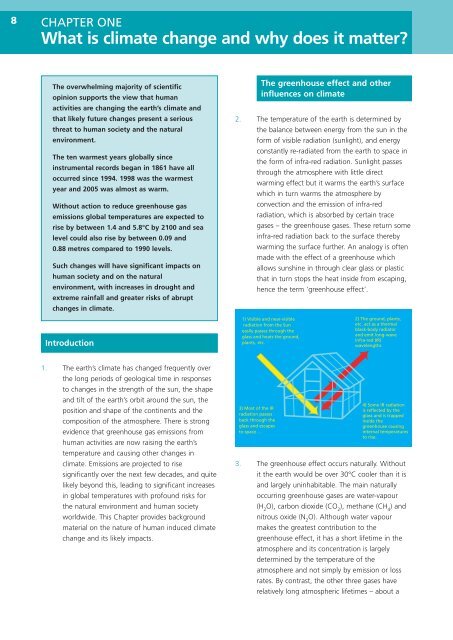UK Climate Change Programme 2006 - JNCC - Defra
UK Climate Change Programme 2006 - JNCC - Defra
UK Climate Change Programme 2006 - JNCC - Defra
Create successful ePaper yourself
Turn your PDF publications into a flip-book with our unique Google optimized e-Paper software.
8<br />
CHAPTER ONE<br />
What is climate change and why does it matter?<br />
The overwhelming majority of scientific<br />
opinion supports the view that human<br />
activities are changing the earth’s climate and<br />
that likely future changes present a serious<br />
threat to human society and the natural<br />
environment.<br />
The ten warmest years globally since<br />
instrumental records began in 1861 have all<br />
occurred since 1994. 1998 was the warmest<br />
year and 2005 was almost as warm.<br />
Without action to reduce greenhouse gas<br />
emissions global temperatures are expected to<br />
rise by between 1.4 and 5.8°C by 2100 and sea<br />
level could also rise by between 0.09 and<br />
0.88 metres compared to 1990 levels.<br />
Such changes will have significant impacts on<br />
human society and on the natural<br />
environment, with increases in drought and<br />
extreme rainfall and greater risks of abrupt<br />
changes in climate.<br />
The greenhouse effect and other<br />
influences on climate<br />
2. The temperature of the earth is determined by<br />
the balance between energy from the sun in the<br />
form of visible radiation (sunlight), and energy<br />
constantly re-radiated from the earth to space in<br />
the form of infra-red radiation. Sunlight passes<br />
through the atmosphere with little direct<br />
warming effect but it warms the earth’s surface<br />
which in turn warms the atmosphere by<br />
convection and the emission of infra-red<br />
radiation, which is absorbed by certain trace<br />
gases – the greenhouse gases. These return some<br />
infra-red radiation back to the surface thereby<br />
warming the surface further. An analogy is often<br />
made with the effect of a greenhouse which<br />
allows sunshine in through clear glass or plastic<br />
that in turn stops the heat inside from escaping,<br />
hence the term ‘greenhouse effect’.<br />
Introduction<br />
1) Visible and near-visible<br />
radiation from the Sun<br />
easily passes through the<br />
glass and heats the ground,<br />
plants, etc.<br />
2) The ground, plants,<br />
etc. act as a thermal<br />
black-body radiator<br />
and emit long-wave<br />
infra-red (IR)<br />
wavelengths<br />
1. The earth’s climate has changed frequently over<br />
the long periods of geological time in responses<br />
to changes in the strength of the sun, the shape<br />
and tilt of the earth’s orbit around the sun, the<br />
position and shape of the continents and the<br />
composition of the atmosphere. There is strong<br />
evidence that greenhouse gas emissions from<br />
human activities are now raising the earth’s<br />
temperature and causing other changes in<br />
climate. Emissions are projected to rise<br />
significantly over the next few decades, and quite<br />
likely beyond this, leading to significant increases<br />
in global temperatures with profound risks for<br />
the natural environment and human society<br />
worldwide. This Chapter provides background<br />
material on the nature of human induced climate<br />
change and its likely impacts.<br />
3) Most of the IR<br />
radiation passes<br />
back through the<br />
glass and escapes<br />
to space ...<br />
4) Some IR radiation<br />
is reflected by the<br />
glass and is trapped<br />
inside the<br />
greenhouse causing<br />
internal temperatures<br />
to rise.<br />
3. The greenhouse effect occurs naturally. Without<br />
it the earth would be over 30°C cooler than it is<br />
and largely uninhabitable. The main naturally<br />
occurring greenhouse gases are water-vapour<br />
(H 2<br />
O), carbon dioxide (CO 2<br />
), methane (CH 4<br />
) and<br />
nitrous oxide (N 2<br />
O). Although water vapour<br />
makes the greatest contribution to the<br />
greenhouse effect, it has a short lifetime in the<br />
atmosphere and its concentration is largely<br />
determined by the temperature of the<br />
atmosphere and not simply by emission or loss<br />
rates. By contrast, the other three gases have<br />
relatively long atmospheric lifetimes – about a
















